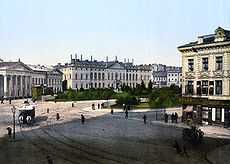Krasiński Palace
| Palace of the Commonwealth Pałac Krasińskich (Polish) | |
|---|---|
 Krasiński Palace, view from the gardens | |
| General information | |
| Architectural style | Baroque |
| Town or city | Warsaw |
| Country | Poland |
| Construction started | 1677 |
| Completed | 1683 |
| Demolished | 1944 |
| Client | Jan Dobrogost Krasiński |
| Design and construction | |
| Architect | Tylman Gamerski |
The Krasiński Palace (Polish: Pałac Krasińskich, otherwise known as Palace of the Commonwealth — Pałac Rzeczypospolitej), is a baroque palace in Warsaw, Poland. It is located on Krasiński Square (Plac Krasińskich).
History

The palace was built in 1677-83 for the Voivode of Płock, Jan Dobrogost Krasiński, according to design by Tylman Gamerski. It was decorated with pediment reliefs showing the triumph of the legendary "ancestor" of the Ślepowron and Korwin Polish clans, the Roman commander Manius Valerius Maximus Corvinus Messalla (263BC) and sculptural work, all by Andreas Schlüter.[1] The first floor porte-fenêtre (vertical French door/window) was crowned with a cartouche supported by two angels bearing the founder's monogram JK. It had many baroque decorations inside. The frescoes were made by Jan III Sobieski's court painter Michelangelo Palloni.[1] Among his notable works in the palace, most worth mentioning are the plafond and frescoes in the supraportes (the space between the portal and ceiling, usually richly decorated) of the palace's vestibule. The interiors were partially finished in 1699. Other paintings by Albrecht Dürer, Antonio da Correggio, Rembrandt and Peter Paul Rubens are no longer present.[2]
According to Gamerski's conception, the palace was intended as a French style palace entre cour et jardin (between the entrance court and the garden) with cour d'honneur, two symmetrical outbuildings, parterre garden (à la française) with three radial alleys and a palace in the center of the axis, but it was never fully accomplished.
In 1765 the palace was purchased by the Rzeczpospolita (the Polish State) as a seat of the Treasury Commission. After a fire in 1783 it was partly rebuilt inside according to Domenico Merlini's design.[1] During the interwar period, the palace housed the Supreme Court of Poland.
The palace was burned down and demolished by the Germans during the World War II.[3][4] It was later rebuilt. Today it is a part of the Polish National Library's Special Collections Section (Manuscripts and Old Prints) from the Załuski Library (only 5% of former rich collection located in the palace, which was deliberately destroyed by the Germans after the collapse of the Warsaw Uprising in October 1944).[5][6]
The building's facade features sculptures by Andreas Schlüter. The decorations inside the building were designed in the 1780s by Domenico Merlini and were restored after World War II. Nearby there is the Krasiński Garden, accessible to the public since 1768.
Images
-

Krasinski Square, 1890s
-
.jpg)
Soon after World War II
-

Garden façade
-

Pediment: Triumph of Marcus Valerius Corvinus by Andreas Schlüter
-

View from the garden
See also
| Wikimedia Commons has media related to Krasiński Palace. |
- Field Cathedral of the Polish Army
- Załuski Library
- Czapski Palace - Warsaw's other palace that is sometimes called "Krasiński Palace"
Notes
- ↑ 1.0 1.1 1.2 (Polish) Stefan Kieniewicz, ed. (1984). Warszawa w latach 1526-1795 (Warsaw in 1526-1795). Warsaw. ISBN 83-01033-23-1.
- ↑ (English) "Krasiński Palace". eGuide / Treasures of Warsaw on-line. Retrieved 2008-09-22.
- ↑ (Polish) Krystyna Kreyser. "Pałac Krasińskich". www.gazetaecho.pl ("Puls Warszawy" No. 10). Retrieved 2009-03-29.
- ↑ (Polish) "Plac Krasińskich i ulica Długa". www.warsawtour.pl. August 1998. Retrieved 2009-03-23.
- ↑ Wanda M. Rudzińska, Straty w zbiorach Gabinetu Rycin Biblioteki Uniwersyteckiej w Warszawie w latach II wojny światowej
- ↑ (Polish) Tomasz Stańczyk (2 October 2004). "Blizny i relikty". www.rzeczpospolita.pl (Rzeczpospolita, No. 232). Retrieved 2009-03-23.
External links
- (Polish) Sąd Najwyższy. Historical pictures of the palace.
- (Polish) Pałac Krasińskich w Warszawie
Coordinates: 52°14′57″N 21°0′18″E / 52.24917°N 21.00500°E